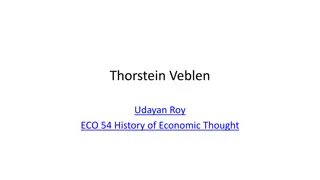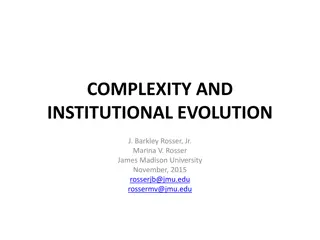
Critiques of Ideology, Myths, and Beliefs in Economic Studies
Explore critiques of ideology and beliefs surrounding economic structures, consumerism, and social hierarchies by prominent thinkers like Thorstein Veblen and Loic Wacquant. Analyze the transition from peaceful savagery to predatory phases of life and the emergence of the leisure class.
Download Presentation

Please find below an Image/Link to download the presentation.
The content on the website is provided AS IS for your information and personal use only. It may not be sold, licensed, or shared on other websites without obtaining consent from the author. If you encounter any issues during the download, it is possible that the publisher has removed the file from their server.
You are allowed to download the files provided on this website for personal or commercial use, subject to the condition that they are used lawfully. All files are the property of their respective owners.
The content on the website is provided AS IS for your information and personal use only. It may not be sold, licensed, or shared on other websites without obtaining consent from the author.
E N D
Presentation Transcript
CRITIQUES OF IDEOLOGY, MYTHS AND BELIEFS
THORSTEIN VEBLEN (1857-1929) The Leisure Class and Conspicuous Consumption
When the community passes from peaceable savagery to a predatory phase of life, the conditions of emulation change. The opportunity and the incentive to emulate increase greatly in scope and urgency. The activity of the men more and more takes on the character of exploit; and an invidious comparison of one hunter or warrior with another grows continually easier and more habitual. Tangible evidences of prowess - trophies - find a place in men's habits of thought as an essential feature of the paraphernalia of life Aggression becomes the accredited form of action, and booty serves as prima facie evidence of successful aggression. As accepted at this cultural stage, the accredited, worthy form of self-assertion is contest; and useful articles or services obtained by seizure or compulsion, serve as a conventional evidence of successful contest. Therefore, by contrast, the obtaining of goods by other methods than seizure comes to be accounted unworthy of man in his best estate. The performance of productive work, or employment in personal service, falls under the same odium for the same reason. An invidious distinction in this way arises Labor acquires a character of irksomeness by virtue of the indignity imputed to it. (Introduction, Theory of the Leisure Class) 3
HUSTLING AS STRUCTURE & STRATEGY (LOIC WACQUANT) To hustle denotes a field of activities which have in common the fact that they require mastery of a particular type of symbolic capital, namely, the ability to manipulate others, to inveigle and deceive them, if need be by joining violence to chicanery and charm, in the pursuit of immediate pecuniary gain. The world of hustling stands in structural opposition to that of wage labor in which, at least in theory, everything is legal, recognized, regular and regulated, recorded and approved by the law (Loic Wacquant, The Weight of the World, pp. 142-143) 4
THE THEORY OF THE LEISURE CLASS: AN ECONOMIC STUDY OF INSTITUTIONS(1899) An early critique of consumerism; also a critique of utilitarianism Economic life is notdriven by notions of utility, but by social vestiges from pre- historic times (e.g., honor) There s always been a division of labor - along status lines high-status groups monopolized war and hunting low-status groups tasked with farming & cooking Primitive cultures featured status rankings for tribes Conquerors gave menial, labor-intensive jobs to subjugated people, while retaining warlike and violent work Members of inferior groups emulated those of higher-status 5
LEISURE CLASS Leisure class: emerging ruling class that benefits most from a capitalist economic system built on waste When they worked it was largely symbolic and peripheral Leisure class retained its position through coercion, direct & indirect, e.g., reserved for itself the honor of warfare, often prevented lower classes from owning weapons or learning how to fight fostered sense of dependency among rest of the tribe on the leisure class due to fear of hostilities from other tribes or, as religions began to form, hostility of imagined deities 6 Veblen characterizes the first priests and religious leaders as members of the leisure class
CONSPICUOUS CONSUMPTION & CONSPICUOUS LEISURE conspicuous consumption: the use of money or other resources to display a higher social status, e.g., Veblen goods refers to commodities for which people's demand increases as their price increases, since greater price confers greater status, instead of decreasing according to the law of demand handbags, watches, etc. conspicuous leisure: time given to certain pursuits in return for higher status, e.g., to be a gentleman one must study things like the fine arts & philosophy, which have little economic value in themselves but display freedom from economic necessity 7
LEISURE CLASS & CONSPICUOUS CONSUMPTION Members of all classes waste both time & money as means to improve self-esteem & elevate status Parasitic business leaders sabotaged the industrial system in their personal quest for profit Modern-day conflict is between: business - those who make money industry - those who make things 8
SOCIAL IMPLICATIONS Subjugation of women Trophy wife shows off a man s success like barbarians trophies of war By not allowing his wife to work outside the home, a man could show off her conspicuous leisure as proof of his status and spend money on his wife through conspicuous consumption Growth of sports such as football Used to display conspicuous leisure Religion as an expression of both conspicuous leisure and conspicuous consumption From an economic point of view, churches are a waste of building space, the clergy a group paid to do nothing useful Manners and etiquette become practices of conspicuous leisure with no practical value 9
ANTONIO GRAMSCI (1891-1937) Hegemony and the Ruling Ideas
HEGEMONY Hegemony refers to ideological domination over subordinate classes Bourgeoisie maintained dominance not primarily through coercion or force but through spontaneous consent of the ruled 11
IDEOLOGICAL SUPERSTRUCTURE HAS TWO LEVELS political society: the State; the police, the army, legal system, etc., which dominates directly and coercively civil society: the family, the education system, trade unions, etc., where leadership is constituted through ideology or by means of consent 12
WHY DID EUROPES WORKING CLASS ACT AGAINST ITS OWN CLASS INTERESTS BY SUPPORTING FASCISM? Proletariat adopts as its own the values, beliefs & attitudes that serve the interests of the ruling class It s socialized esp. through educational system into accepting bourgeois ideology as an unquestioned commonsense view of the world and their place in it 13
COUNTER-HEGEMONY IS REQUIRED TO SPARK UNIFIED POPULAR REVOLT Counter-hegemonyor organic consciousness would unmask the real sources of workers oppression and articulate the real interests and needs of the masses Praxis: connects theoretical insights to active attempts to create a more just society 14



